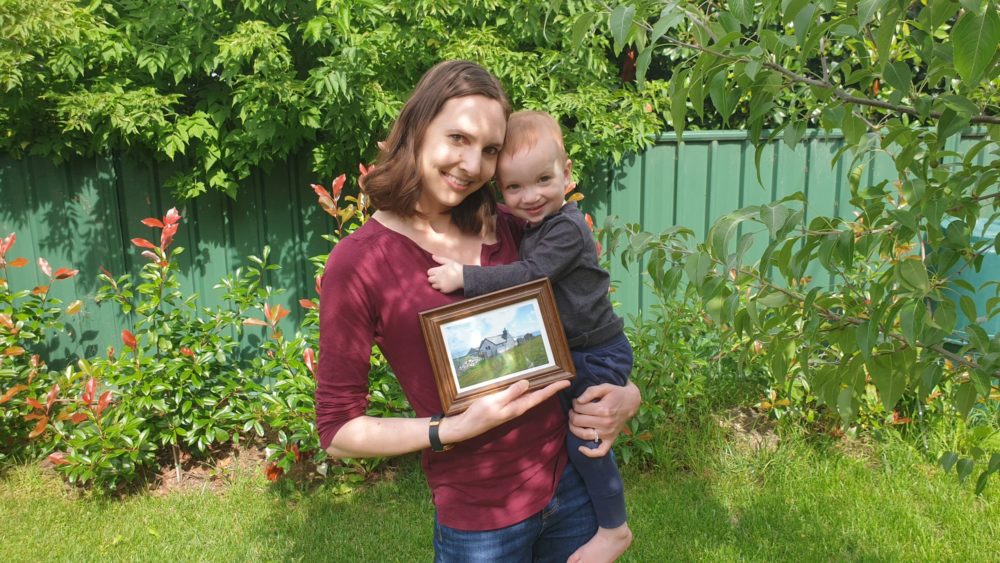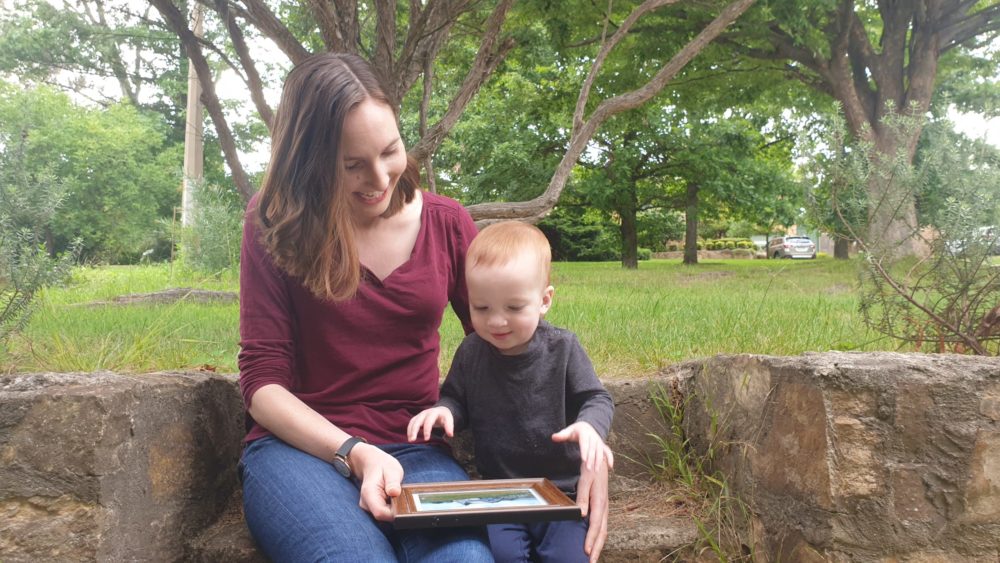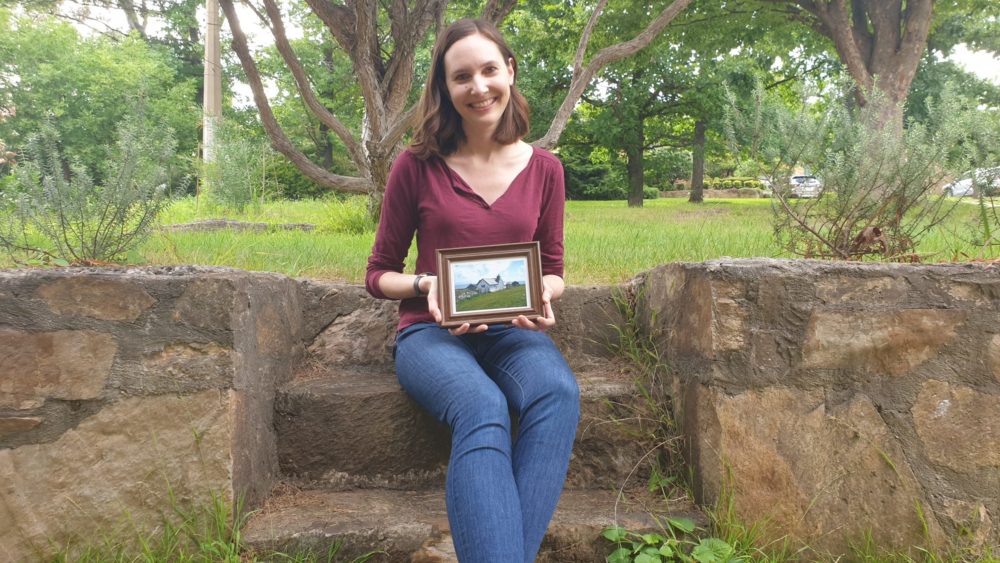The American learning Welsh in Australia to share with her son

While she started learning Welsh to connect with her own heritage, American Liz Williams, who now lives in Australia, continues to learn and speak Welsh so that it can be passed down to the next generation.
“When I was growing up, I regularly heard the Welsh language,” Liz said. “Our church was full of people with Welsh ancestry, and I learned to sing in Welsh from a young age.”
Liz was raised in an area of central New York that was a hub of Welsh immigration in the late 1800s, and many traditions were passed down through the generations.
As a child, she often attended cymanfaoedd canu (traditional Welsh hymn-singing events) with her family as a way to stay connected to their Welsh heritage.
Cymanfa Ganu
“When I was five years old, the Welsh National Gymanfa Ganu came to Utica, New York, where I lived. My parents dressed me up for the festival in a traditional Welsh costume with a tall black hat, white apron and a black and red checkered shawl.
I remember learning the words to Calon Lân and other hymns in Welsh. But aside from those hymns and a few basic words, we had no real knowledge of the Welsh language.”
Liz’s family connection to Wales traces back to her great-great-grandfather, who emigrated in 1886 from his home near Aberdaron, Gwynedd, and settled in central New York.
Like many other Welsh immigrants at that time, he was committed to preserving his culture in his new country. He continued to speak Welsh, became active in a Welsh church, and was involved with local Eisteddfod events.
Preserving Language as an immigrant
“It wasn’t until I became an immigrant myself, relocating to Australia in 2018, that I started to understand some of what my Welsh ancestors would have experienced when leaving their homeland. While our immigrant stories are different in many ways, we each had to decide which parts of our language, heritage and culture we kept with us in our new country, and which parts we left behind.”
For Liz, she sees value in preserving not only her American heritage but also her Welsh heritage, in her new country. Her son, Levin, was born in Australia in 2022 and she hopes to share her love of Wales and the Welsh language with him as he grows.
“Although my son has only known Australia as his home, I want him to know more about where our family comes from—not only New York, but Wales before that,” Liz said.
On their commute to work and childcare each day, Liz and Levin listen to Radio Cymru in the car, and he already knows a few words in Welsh, too.

“After researching my own family history, I have seen how fragile the survival of a language within a family can be,” Liz said.
While her great-grandfather was a Welsh-speaking minister in America, he tragically died at age 34 from a ruptured appendix in 1932, just a few months before his son (Liz’s grandfather) was born. As a result, he never got the chance to pass the Welsh language on to his children. His death marked the end of Welsh being spoken in Liz’s family—until now.
Learning Welsh Down Under
Liz started learning Welsh in 2012, through the Say Something in Welsh course, after a visit to her great-great-grandfather’s house near Aberdaron, Gwynedd.
“I realised on that trip that learning the language of my ancestors was the key to more fully connecting with this part of my heritage, and with my distant relatives still living in Wales,” Liz said.
She has continued learning over the years, first in the United States and now in Australia, by attending in-person language classes, using apps like Duolingo, watching programmes on S4C, and listening to Radio Cymru. Some of her favourite Welsh artists at the moment are Sŵnami, Gwenno and Bronwen Lewis, although she enjoys any opportunity to listen to the language.
Indigenous languages
“When I first arrived in Melbourne, I was excited to find the Melbourne Welsh Church, which offers services in Welsh as well as a language class. Attending this church was an opportunity to listen to native speakers and practice my Welsh in person.”
Living in Australia, Liz has also seen how Indigenous communities work to preserve language as a key part of their culture. While working at the University of Melbourne, she came across the Research Unit for Indigenous Language, a group working with Indigenous communities across Australia to help record their languages. The 50 Words Project, led by this group, aims to provide fifty words in every Indigenous language of Australia.

“Since moving here, I have heard again and again how important language is to culture—not only for Indigenous Australians but for immigrants, too,” Liz said.
According to the Australian Bureau of Statistics, the proportion of Australia’s population born overseas was 29.5% in 2022. Living in a place with such a high population of immigrants, Liz is not alone in her efforts to preserve her culture and identity. Recently, she relocated to Canberra, and linked up with another learner’s community there which is primarily made up of Welsh expats.
Strategies for Learning
Liz’s advice to other learners is to incorporate a variety of learning methods and seek out community wherever possible.
“As Welsh learners today, we are so fortunate to have a wealth of digital resources at our fingertips. I can video chat with my distant relatives in Wales, connect with other learners online, and listen to Welsh music on my commute to work. I don’t feel at a disadvantage in my learning journey being located so far away from Wales.”
When she was just a few weeks pregnant in 2021, Liz began a weekly course online through the National Centre for Learning Welsh. By the end of the nine-month class, her son was born and she was already speaking and singing to him in Welsh.
“I see learning Welsh as a lifelong journey—I can always keep chipping away at it, learning when I can. I have gone through phases where my learning journey slows, like when I was caring for a newborn. But I always find my way back and continue learning—even if it’s just a few Duolingo lessons each week or catching up on the latest episode of Rownd a Rownd on S4C.”
Safeguarding
Liz’s newfound knowledge of the Welsh language over the past few years helped her to translate old family documents into English. This uncovered new information and stories about her Welsh ancestors. She hopes to not only pass down the language to the next generation, but also an understanding of why it is so important to safeguard cultural heritage and celebrate where we come from.
“I have found that preserving my Welsh heritage and identity gives me a greater sense of belonging, connection, and grounding, wherever in the world I may be,” said Liz.
Liz Williams is an American writer living in Australia with family ties to Wales. She is writing a book on the themes discussed in this article and can be contacted through her website at lizwilliamswrites.com.
Click here to find out more about SaySomethingInWelsh.
Click here for more info on DuoLingo.
Click here for information on local Wales-based Welsh classes or London classes (Not exhaustive so please check social media and search engines for what’s on in your area)
Support our Nation today
For the price of a cup of coffee a month you can help us create an independent, not-for-profit, national news service for the people of Wales, by the people of Wales.





“According to the Australian Bureau of Statistics, the proportion of Australia’s population born overseas was 29.5% in 2022.”
It’s something similar in Wales. In 2011 27 per cent (837,000) of the total population of Wales were not born in Wales, including 636,000 people (21 per cent of the total population of Wales) who were born in England.
Only 3% of the population of Australia are First Nation Aboriginal.
Recently colonial statues of Captain Cook and Queen Victoria have been vandalized which usually happens around the time of Australia Day on January 26th.